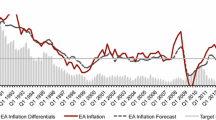Abstract
Following their EU accession, the new member countries from Central and Eastern Europe (CEE) must achieve sustainable price stability as one of the pre-conditions for joining the Economic and Monetary Union (EMU) and adopting the euro. This article examines the distribution dynamics of inflation rates in ten new EU members from CEE relative to the EMU accession benchmark inflation over the period 1990–2009. In contrast to previous studies, we use nonparametric methods to test for convergence in inflation rates between CEE and the EMU benchmark as well as within the CEE sample. Over the entire sample period, we detect a general shift in the CEE inflation distribution toward the EMU benchmark along with intradistributional convergence. However, this process is not uniform. In the early years, it was equally likely for CEE inflation rates to move toward or away from the benchmark. The resulting multimodal distribution gave way to a unimodal distribution in the years leading up to the EU accession, accompanied by a marked shift toward the EMU benchmark. In more recent years, emergence of a bimodal distribution signaled the stratification of relative inflation in CEE into two convergence clubs, which has intensified since the start of the global economic crisis.
Similar content being viewed by others
References
Backe P, Fidrmuc J, Reininger T, Schardax F (2002) Price dynamics in Central and Eastern European EU accession countries. Oesterreichische National Bank Working Paper 61
Baltagi BH (2005) Econometric analysis of panel data, 3rd edn. Wiley, West Sussex
Barro RJ, Sala-i-Martin X (1992) Convergence. J Political Econ 100: 223–251
Beck G, Weber A (2005) Price stability, inflation convergence and diversity in EMU: does one size fit all? Center for Financial Studies Working Paper 30
Becker B, Hall S (2009) How far from the Euro Area? Measuring convergence of inflation rates in Eastern Europe. Econ Modell 26: 788–798
Brada JC, Kutan A, Zhou S (2005) Real and monetary convergence between the European Union’s core and recent member countries: a rolling cointegration approach. J Banking Finance 29: 249–270
Buiter W (2005) To purgatory and beyond: When and how should the accession countries from Central and Eastern Europe become full members of the EMU?. In: Breuss F, Hochreiter E (eds) Challenges for Central Banks in an enlarged EMU. Springer, New York, pp 145–186
Camarero M, Esteve V, Tamarit C (2000) Price convergence of peripheral European countries on the way to the EMU: A time series approach. Empir Econ 25: 149–168
De Grauwe P, Schnabl G (2005) Nominal versus real convergence: EMU entry scenarios for the new member countries. Kyklos 58(4): 537–555
Drine I, Rault C (2006) Testing for inflation convergence between the Eurozone and its CEE partners. Appl Econ Lett 13: 235–240
Egert B (2007) Real convergence, price level convergence and inflation differentials in Europe. CESifo Working Paper No. 2127
Figuet JM, Nenovsky N (2006) Convergence and shocks in the road to EU: Empirical investigations for Bulgaria and Romania. William Davidson Institute Working Paper 810
Frommel M, Schobert F (2006) Exchange rate regimes in Central and East European countries: deeds vs. words. J Comp Econ 34: 467–483
Hyndman R, Bashtannyk D, Grunwald G (1996) Estimating and visualizing conditional densities. J Comput Graph Stat 5: 315–336
Jonas J, Mishkin FS (2004) Inflation targeting in transition economies: experience and prospects. In: Bernanke B, Woodford M (eds) The inflation targeting debate. National Bureau of Economic Research, Cambridge
Kocenda E, Kutan A, Yigit T (2006) Pilgrims to the Eurozone: how far, how fast. Econ Syst 30: 311–327
Kutan A, Yigit T (2004) Nominal and real stochastic convergence of transition economies. J Comp Econ 32: 23–36
Lewis J (2009) Hitting or hoping? Meeting the exchange rate and inflation criteria during a period of nominal convergence. Eur J Political Econ 25(4): 508–524
Li Q, Maasoumi E, Racine JS (2009) A Nonparametric test for equality of distributions with mixed categorical and continuous data. J Econom 148: 186–200
Mark NC, Sul D (2008) PPP strikes out: the effect of common factor shocks on the real exchange rate. Mimeo. University of Notre Dame
Nath HK, Tochkov, K (2011) Relative inflation dynamics in the EU Accession Countries of Central and Eastern Europe. Bulgarian National Bank Discussion Papers, DP/84/2011
Orlowski LT (2005) Monetary convergence of the EU accession countries to the eurozone: a theoretical framework and policy implications. J Bank Finance 29: 203–225
Orlowski LT (2008) Relative inflation-forecast as monetary policy target for convergence to the euro. J Policy Model 30: 1061–1081
Orlowski LT (2010) Monetary policy rules for convergence to the Euro. Econ Syst 34: 148–159
Palomba G, Sarno E, Zazzaro A (2009) Testing similarities of short-run inflation dynamics among EU-25 countries after the Euro. Empir Econ 37: 231–270
Purfield C, Rosenberg CB (2010) Adjustment under a currency peg: Estonia, Latvia and Lithuania during the Global Financial Crisis 2008–09. IMF Working Paper (WP/10/213)
Quah DT (1993a) Galton’s fallacy and the convergence hypothesis. Scand J Econ 95: 427–443
Quah DT (1993b) Empirical cross-section dynamics in economic growth. Eur Econ Rev 37: 426–434
Quah DT (1996a) Convergence empirics across economies with (some) capital mobility. J Econ Growth 1: 95–124
Quah DT (1996b) Empirics for economic growth and convergence. Eur Econ Rev 40: 1353–1375
Quah DT (1996c) Twin Peaks: growth and convergence in models of distribution dynamics. Econ J 106: 1045–1055
Quah DT (1997) Empirics for growth and distribution: stratification, polarization and convergence clubs. J Econ Growth 2: 27–59
Siklos P (2010) Meeting Maastricht: nominal convergence of the new member countries toward EMU. Econ Modell 27: 507–515
Author information
Authors and Affiliations
Corresponding author
Rights and permissions
About this article
Cite this article
Nath, H.K., Tochkov, K. Relative inflation dynamics in the new EU member countries of Central and Eastern Europe. Empir Econ 45, 1–22 (2013). https://doi.org/10.1007/s00181-012-0596-y
Received:
Accepted:
Published:
Issue Date:
DOI: https://doi.org/10.1007/s00181-012-0596-y




